Improved Traffic Sign Detection Algorithm Based on Faster R-CNN
Abstract
:1. Introduction
2. Related Works
- (1)
- Owing to the influence of weather and light, the image quality collected by the on-board industrial camera is non-uniform and the environment of various road sections is changeable. Therefore, the detection algorithm is required to be highly robust.
- (2)
- Different types of traffic signs can have similar characteristics. Additionally, in the case of vehicles on highways, the collected images are blurred and distorted, which makes detection difficult.
- (3)
- Although the detection model can extract effective features for smaller traffic sign targets located at a distance, a loss of some detailed information after the multi-layer feature extraction of the network is experienced, which leads to missed and erroneous detection of the model for small-target objects.
- (1)
- Considering the influence of weather and light, we propose a fusion method that fuses the feature pyramid into the Faster R-CNN algorithm. The advantage is that the method can extract object features with precision and the use of the feature pyramid can decrease the influence of weather and light.
- (2)
- To solve the problems of similar characteristics and distorted images, we add the DCN to the backbone network. The advantage of adding the DCN is that the method can train the algorithm to identify traffic signs with precision and make similar signs more distinguishable, and in particular make it work better with distorted images.
- (3)
- To more precisely detect the traffic signs located at a distance, we apply ROI align to replace the ROI pooling. The advantage of using ROI align is that this method can avoid the distant traffic sign detail loss caused by pooling, which can increase the detection precision of distant traffic signs.
3. Methodology
3.1. Introduction to the Faster R-CNN Model
- (1)
- R-CNN
- (2)
- Fast R-CNN
- (3)
- Faster R-CNN
3.2. Feature Extraction Network
3.3. Region Proposal Network
- (1)
- An image is input into the network to obtain the feature map. A sliding window is used to slide on the feature map, and then the candidate regions are predicted in the corresponding position of the sliding window.
- (2)
- Finally, the prediction results are input to the next layer of the full connection layer for classification and regression operation.
3.4. ROI Pooling
4. Model Optimization
4.1. Feature Pyramid
4.2. Improved ROI Pooling
4.3. Add Deformable Convolution to the Backbone Network
5. Experimental Results
5.1. Experiments with Dataset
5.1.1. Experimental Environment and Details
5.1.2. Experimental Analysis
5.2. Experiments with Intelligent Vehicle
5.2.1. Experimental Details
5.2.2. Experimental Analysis
- (1)
- The proposed method performs mAPs of 92.6%, 90.6%, and 86.9% at sunny daytime, sunny sunset, and on a rainy day, respectively. Although the precisions are proportional to the intensity, all the precisions are over 86%. This demonstrates that the proposed method has a high precision and robustness at different conditions.
- (2)
- Compared with SSD, YOLOv2, and YOLOv5, the proposed method exhibits better performance regardless of times or weather conditions. This proves that our method has a higher precision and is more robust than these three methods.
- (3)
- Although YOLOv5 has a higher precision at sunny daytime (mAP of 94.8% and 92.6%), when the intensity is low (sunset or rainy day), the proposed method displays a better performance than YOLOv5 (mAP of 87.6% and 90.6% at sunset, mAP of 76.6% and 86.9% on a rainy day). This proves that our method can maintain a high precision in extreme environments. This makes our method much more practical than others.
6. Conclusions
Author Contributions
Funding
Conflicts of Interest
References
- Poczter, S.L.; Jankovic, L.M. The Google Car: Driving Toward A Better Future. Bus. Case Stud. 2013, 10, 7–14. [Google Scholar] [CrossRef]
- Chen, Z.J.; Wu, C.Z.; Zhang, Y.S.; Huang, Z.; Jiang, J.F.; Lyu, N.C.; Ran, B. Vehicle behavior learning via sparse reconstruction with l2-lp minimization and trajectory similarity. IEEE Trans. Intell. Transp. Syst. 2017, 18, 236–247. [Google Scholar] [CrossRef]
- Cai, Y.; Luan, T.; Gao, H.; Wang, H.; Chen, L.; Li, Y.; Sotelo, M.A.; Li, Z. YOLOv4-5D: An Effective and Efficient Object Detector for Autonomous Driving. IEEE Trans. Instrum. Meas. 2021, 70, 4503613. [Google Scholar] [CrossRef]
- Chen, Z.; Lu, Z.; Chen, Q.; Zhong, H.; Zhang, Y.; Xue, J.; Wu, C. A Spatial–temporal short-term traffic flow prediction model based on dynamical-learning graph convolution mechanism. arXiv 2022, arXiv:2205.04762. [Google Scholar] [CrossRef]
- Wang, H.; Chen, Z.; Cai, Y.; Chen, L.; Li, Y.; Sotelo, M.A.; Li, Z. Voxel-RCNN-Complex: An Effective 3-D Point Cloud Object Detector for Complex Traffic Conditions. IEEE Trans. Instrum. Meas. 2022, 71, 2507112. [Google Scholar] [CrossRef]
- Chen, G.; Chen, K.; Zhang, L.; Zhang, L.; Knoll, A. VCANet: Vanishing-Point-Guided Context-Aware Network for Small Road Object Detection. Automot. Innov. 2021, 4, 400–412. [Google Scholar] [CrossRef]
- Suetake, N.; Uchino, E.; Hirata, K. Generalized Fuzzy Hough Transform for Detecting Arbitrary Shapes in a Vague and Noisy Image. Soft Comput. 2006, 10, 1161–1168. [Google Scholar] [CrossRef]
- Wang, H.; Chen, Y.; Cai, Y.; Chen, L.; Li, Y.; Sotelo, M.A.; Li, Z. SFNet-N: An Improved SFNet Algorithm for Semantic Segmentation of Low-Light Autonomous Driving Road Scenes. IEEE Trans. Intell. Transp. Syst. 2022, 1–13. [Google Scholar] [CrossRef]
- Peng, L.; Wang, H.; Li, J. Uncertainty Evaluation of Object Detection Algorithms for Autonomous Vehicles. Automot. Innov. 2021, 4, 241–252. [Google Scholar] [CrossRef]
- Chen, Z.; Chen, D.; Zhang, Y.; Cheng, X.; Zhang, M.; Wu, C. Deep learning for autonomous ship-oriented small ship detection. Saf. Sci. 2020, 130, 104812. [Google Scholar] [CrossRef]
- Chen, Z.; Cai, H.; Zhang, Y.; Wu, C.; Mu, M.; Li, Z.; Sotelo, M.A. A novel sparse representation model for pedestrian abnormal trajectory understanding. Expert Syst. Appl. 2019, 138, 112753. [Google Scholar] [CrossRef]
- Zhu, Z.; Liang, D.; Zhang, S.; Huang, X.; Li, B.; Hu, S. Traffic-Sign Detection and Classification in the Wild. In Proceedings of the IEEE Conference on Computer Vision and Pattern Recognition (CVPR), Las Vegas, NV, USA, 27–30 June 2016; pp. 2110–2118. [Google Scholar]
- Xie, Y.; Liu, L.F.; Li, C.H.; Qu, Y.Y. Unifying visual saliency with HOG feature learning for traffic sign detection. In Proceedings of the 2009 IEEE Intelligent Vehicles Symposium, Xi’an, China, 3–5 June 2009; pp. 24–29. [Google Scholar]
- Yang, Y.; Wu, F. Real-Time Traffic Sign Detection via Color Probability Model and Integral Channel Features. In Communications in Computer and Information Science, Proceedings of the 6th Chinese Conference on Pattern Recognition, Changsha, China, 17–19 November 2014; Springer: Berlin/Heidelberg, Germany, 2014; pp. 545–554. [Google Scholar] [CrossRef]
- García-Garrido, M.Á.; Sotelo, M.Á.; Martín-Gorostiza, E. Fast road sign detection using Hough transform for assisted driving of road vehicles. In Computer Aided Systems Theory—EUROCAST 2005, Proceedings of the 10th International Conference on Computer Aided Systems Theory, Las Palmas de Gran Canaria, Spain, 7–11 February 2005; Springer: Berlin/Heidelberg, Germany, 2005; pp. 543–548. [Google Scholar]
- Boumediene, M.; Cudel, C.; Basset, M.; Ouamri, A. Triangular traffic signs detection based on RSLD algorithm. Mach. Vis. Appl. 2013, 24, 1721–1732. [Google Scholar] [CrossRef]
- Krizhevsky, A.; Sutskever, I.; Hinton, G.E. Imagenet classification with deep convolutional neural networks. Commun. ACM 2012, 60, 84–90. [Google Scholar] [CrossRef]
- Zhang, S.; Bauckhage, C.; Cremers, A.B. Informed Haar-Like Features Improve Pedestrian Detection. In Proceedings of the IEEE Conference on Computer Vision and Pattern Recognition, Columbus, OH, USA, 24–27 June 2014; pp. 947–954. [Google Scholar]
- Girshick, R.; Donahue, J.; Darrell, T.; Malik, J. Rich Feature Hierarchies for Accurate Object Detection and Semantic Segmentation. In Proceedings of the IEEE Conference on Computer Vision and Pattern Recognition, Columbus, OH, USA, 24–27 June 2014; pp. 580–587. [Google Scholar]
- Girshick, R. Fast R-CNN. In Proceedings of the IEEE International Conference on Computer Vision, Washington, DC, USA, 7–13 December 2015; pp. 1440–1448. [Google Scholar]
- Ren, S.; He, K.; Girshick, R.; Sun, J. Faster R-CNN: Towards Real-Time Object Detection with Region Proposal Networks. IEEE Trans. Pattern Anal. Mach. Intell. 2016, 39, 1137–1149. [Google Scholar] [CrossRef]
- Redmon, J.; Farhadi, A. YOLO9000: Better, Faster, Stronger. In Proceedings of the IEEE Conference on Computer Vision & Pattern Recognition, Honolulu, HI, USA, 21–26 July 2017; pp. 6517–6525. [Google Scholar]
- Liu, W.; Anguelov, D.; Erhan, D.; Szegedy, C.; Reed, S.; Fu, C.Y.; Berg, A.C. SSD: Single Shot MultiBox Detector. In Computer Vision—ECCV 2016, Proceedings of the European Conference on Computer Vision, Amsterdam, The Netherlands, 11–14 October 2016; Springer International Publishing: Berlin/Heidelberg, Germany, 2016; pp. 21–37. [Google Scholar]
- Redmon, J.; Farhadi, A. YOLOv3: An Incremental Improvement. arXiv 2018, arXiv:1804.02767. [Google Scholar]
- He, K.; Zhang, X.; Ren, S.; Sun, J. Deep Residual Learning for Image Recognition. In Proceedings of the IEEE Conference on Computer Vision and Pattern Recognition, Las Vegas, NV, USA, 27–30 June 2016; pp. 770–778. [Google Scholar]
- Mao, Q.C.; Sun, H.M.; Liu, Y.B.; Jia, R.S. Mini-YOLOv3: Real-Time Object Detector for Embedded Applications. IEEE Access 2019, 7, 133529–133538. [Google Scholar] [CrossRef]
- Kuznetsova, A.; Maleva, T.; Soloviev, V. Detecting Apples in Orchards Using YOLOv3 and YOLOv5 in General and Close-Up Images. In Proceedings of the International Symposium on Neural Networks, Cairo, Egypt, 4–6 December 2020; pp. 233–243. [Google Scholar]
- Xing, J.; Yan, W.Q. Traffic Sign Recognition Using Guided Image Filtering. In Geometry and Vision, Proceedings of the First International Symposium, ISGV 2021, Auckland, New Zealand, 28–29 January 2021; Springer: Berlin/Heidelberg, Germany, 2021; Volume 1386, pp. 85–99. [Google Scholar] [CrossRef]
- Xu, S.; Niu, D.; Tao, B.; Li, G. Convolutional Neural Network Based Traffic Sign Recognition System. In Proceedings of the 5th International Conference on Systems and Informatics (ICSAI), Nanjing, China, 10–12 November 2018; pp. 957–961. [Google Scholar] [CrossRef]
- Sun, Y.; Sun, C.; Wang, D.; He, Y.; Lu, H. ROI Pooled Correlation Filters for Visual Tracking. In Proceedings of the 2019 IEEE/CVF Conference on Computer Vision and Pattern Recognition (CVPR), Long Beach, CA, USA, 15–20 June 2019; p. 19262751. [Google Scholar]
- He, K.; Gkioxari, G.; Dollár, P.; Girshick, R. Mask R-CNN. In Proceedings of the IEEE International Conference on Computer Vision, Venice, Italy, 22–29 October 2017; pp. 2980–2988. [Google Scholar]
- Zhu, Y.; Yan, W.Q. Traffic sign recognition based on deep learning. Multimedia Tools Appl. 2022, 81, 17779–17791. [Google Scholar] [CrossRef]
- Simonyan, K.; Zisserman, A. Very Deep Convolutional Networks for Large-Scale Image Recognition. arXiv 2014, arXiv:1409.1556. [Google Scholar]
- Purkait, P.; Zhao, C.; Zach, C. SPP-Net: Deep Absolute Pose Regression with Synthetic Views. arXiv 2017, arXiv:1712.03452. [Google Scholar]
- Adelson, E.H.; Anderson, C.H.; Bergen, J.R.; Burt, P.J.; Ogden, J.M. Pyramid methods in image processing. RCA Eng. 1984, 29, 33–41. [Google Scholar]
- Lin, T.Y.; Dollár, P.; Girshick, R.; He, K.; Hariharan, B.; Belongie, S. Feature Pyramid Networks for Object Detection. In Proceedings of the IEEE Conference on Computer Vision and Pattern Recognition, Honolulu, HI, USA, 21–26 July 2017; pp. 936–944. [Google Scholar]
- Dai, J.; Qi, H.; Xiong, Y.; Li, Y.; Zhang, G.; Hu, H.; Wei, Y. Deformable Convolutional Networks. In Proceedings of the 16th IEEE International Conference on Computer Vision, Venice, Italy, 22–29 October 2017; pp. 764–773. [Google Scholar]
- Stefan, K.; Josien, P.; Marius, S.; Max, A. Adaptive Stochastic Gradient Descent Optimisation for Image Registration. Int. J. Comput. Vis. 2009, 81, 227–239. [Google Scholar]

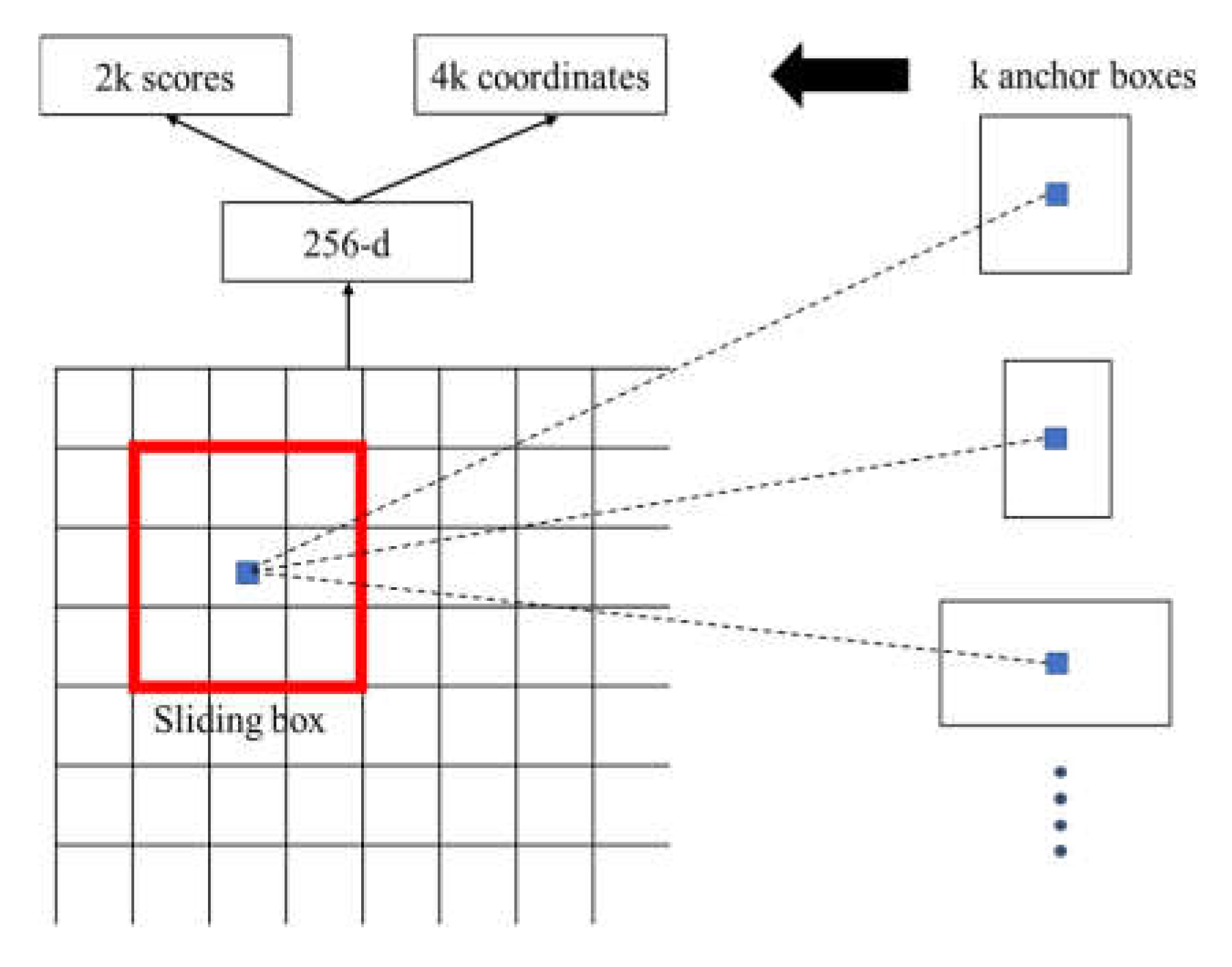

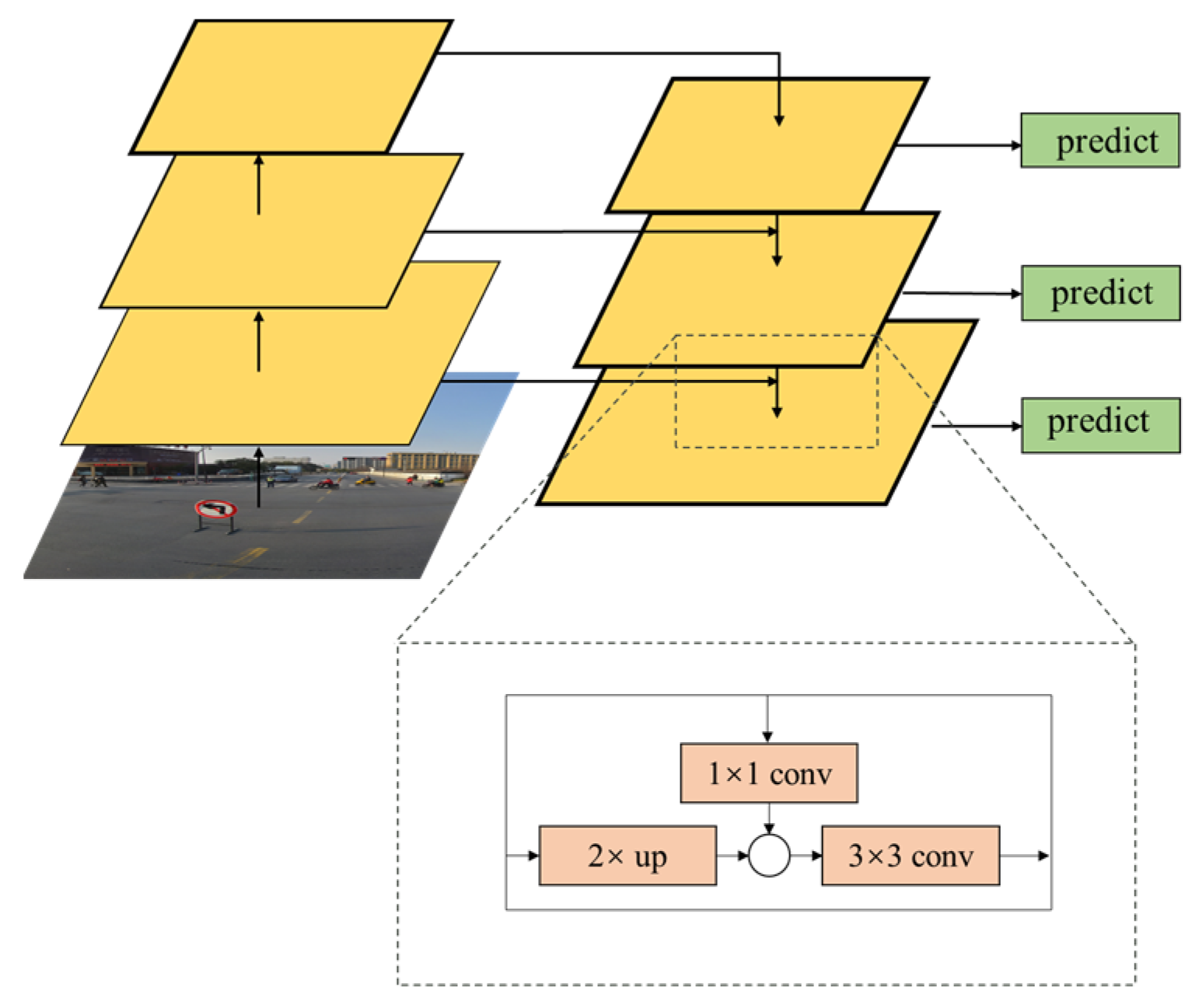
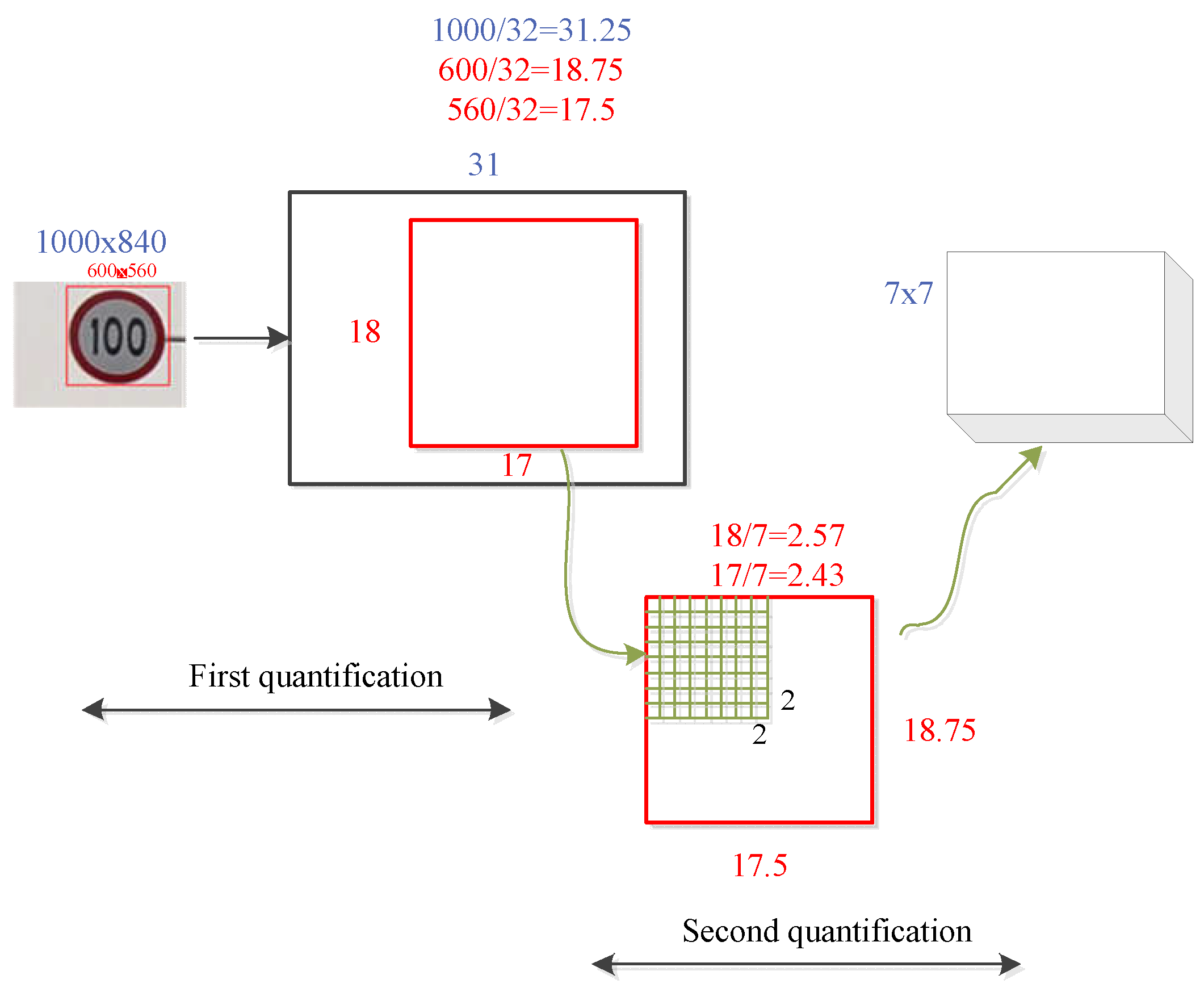

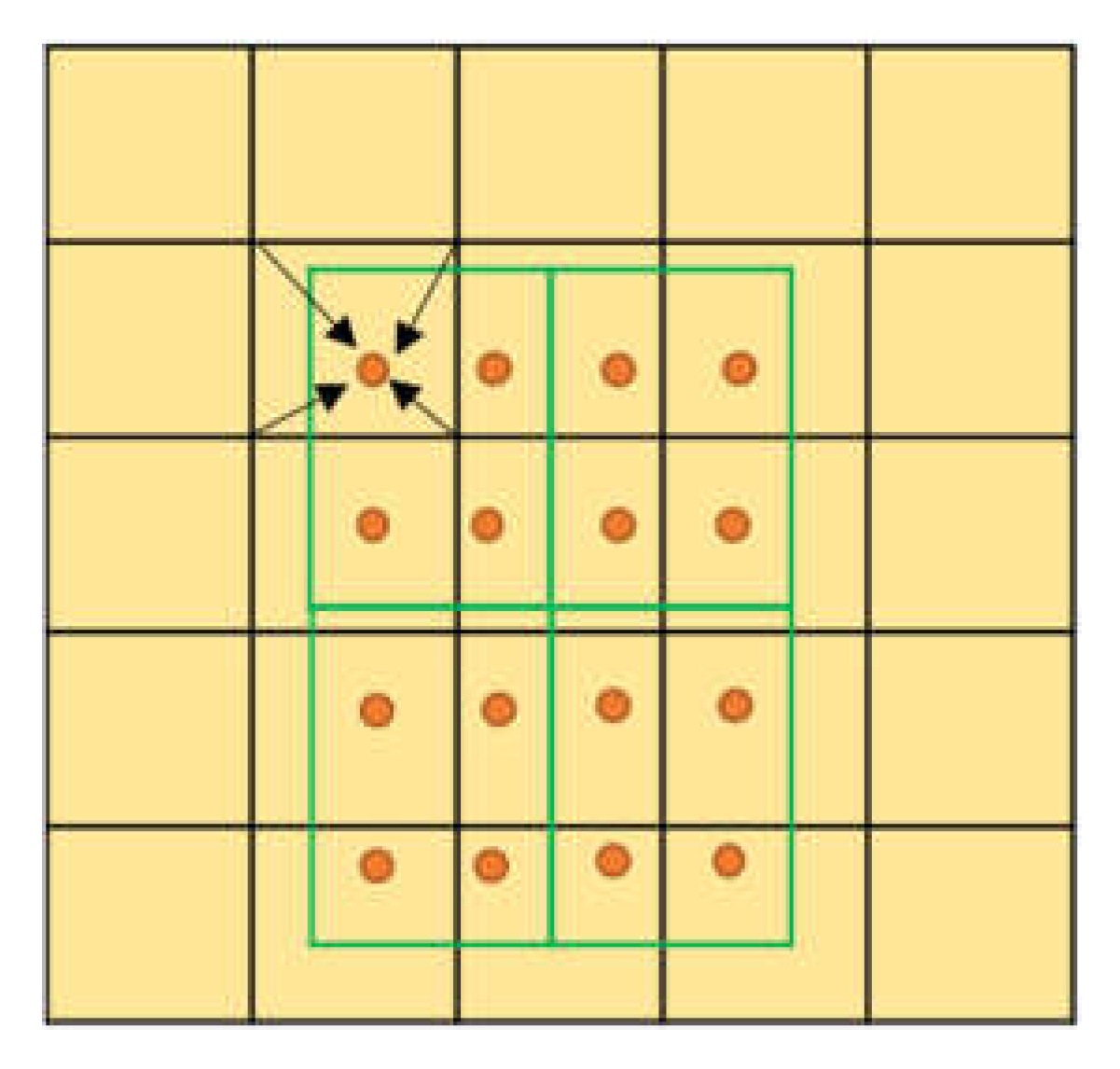
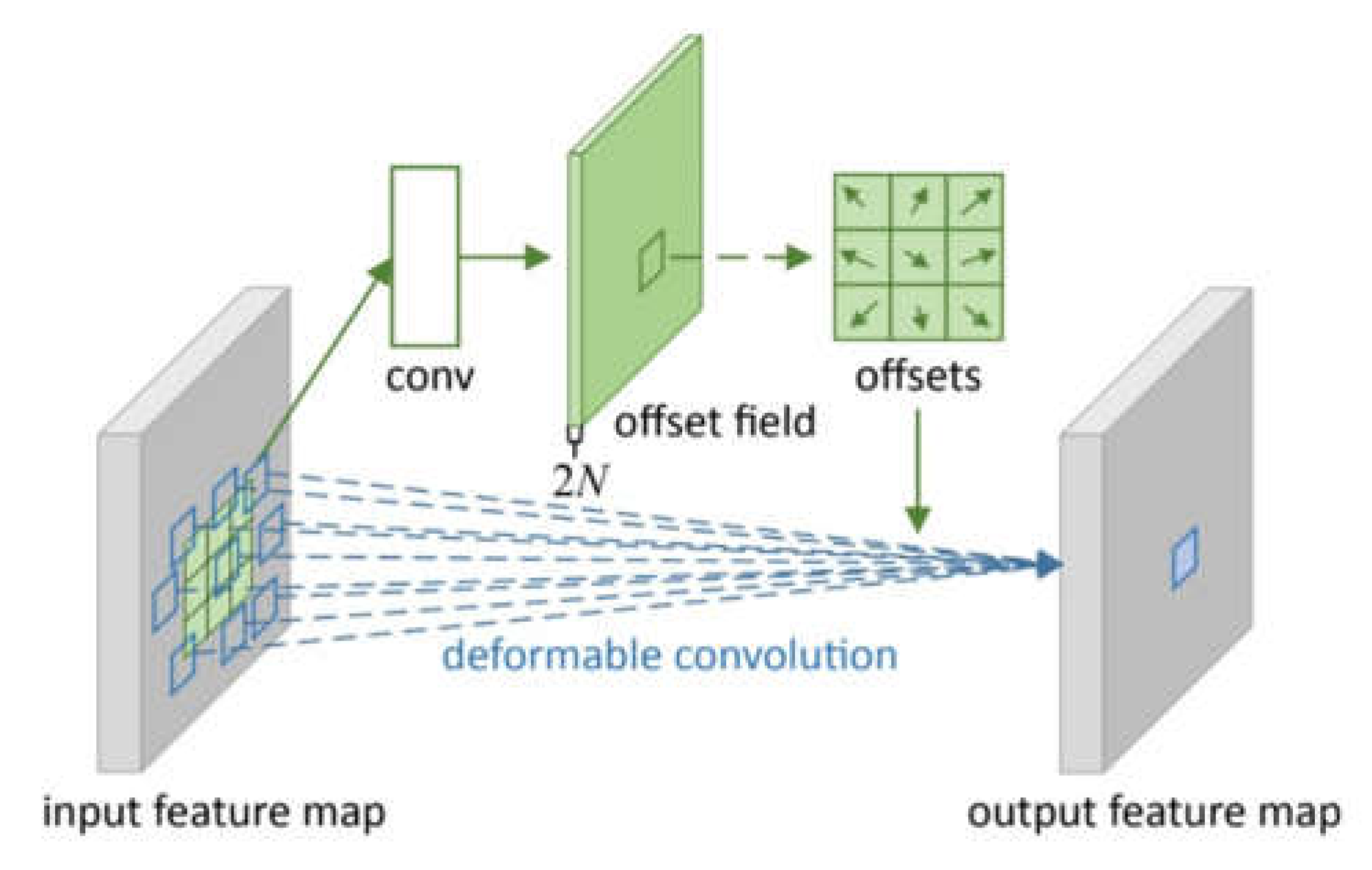

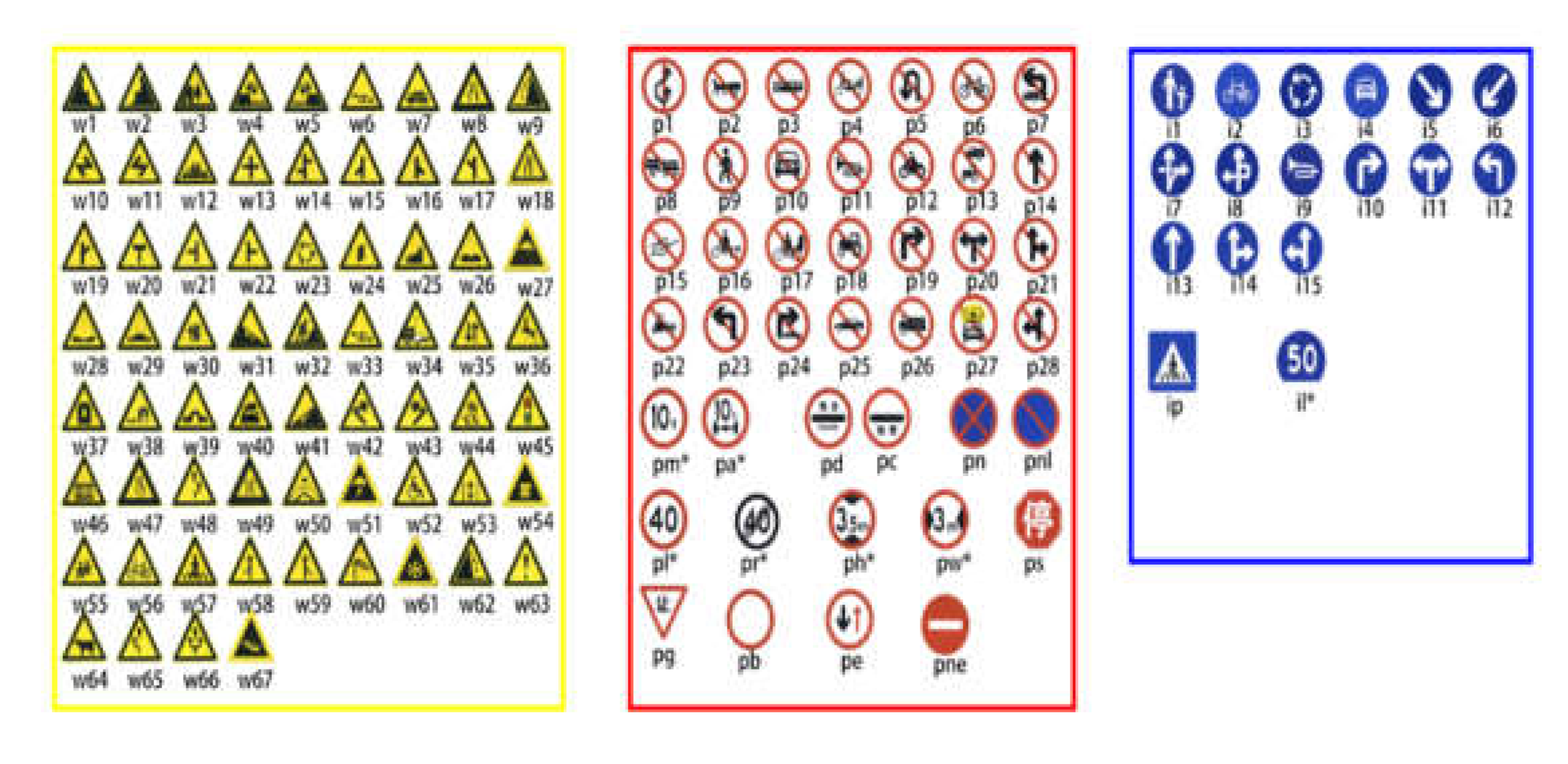
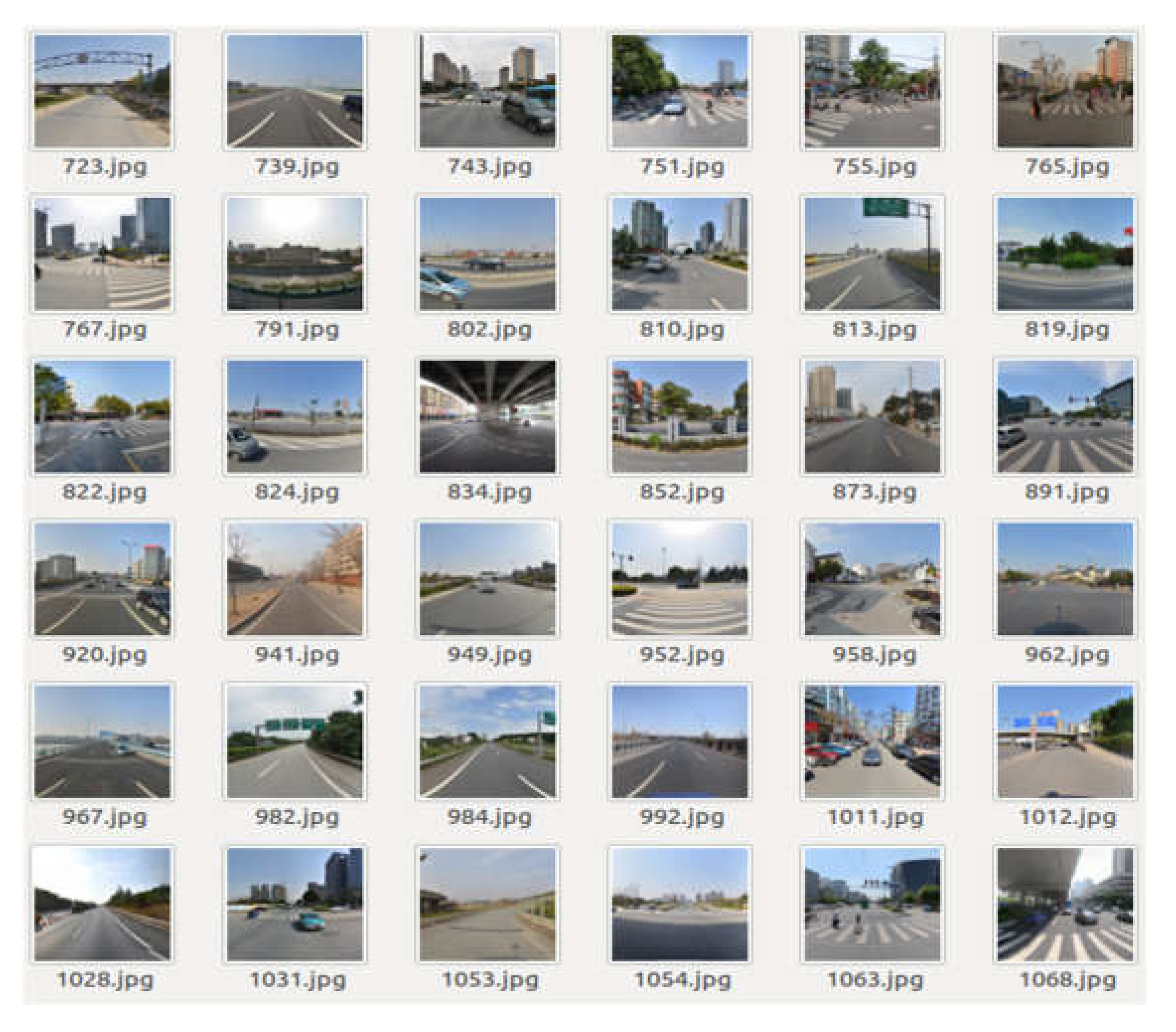
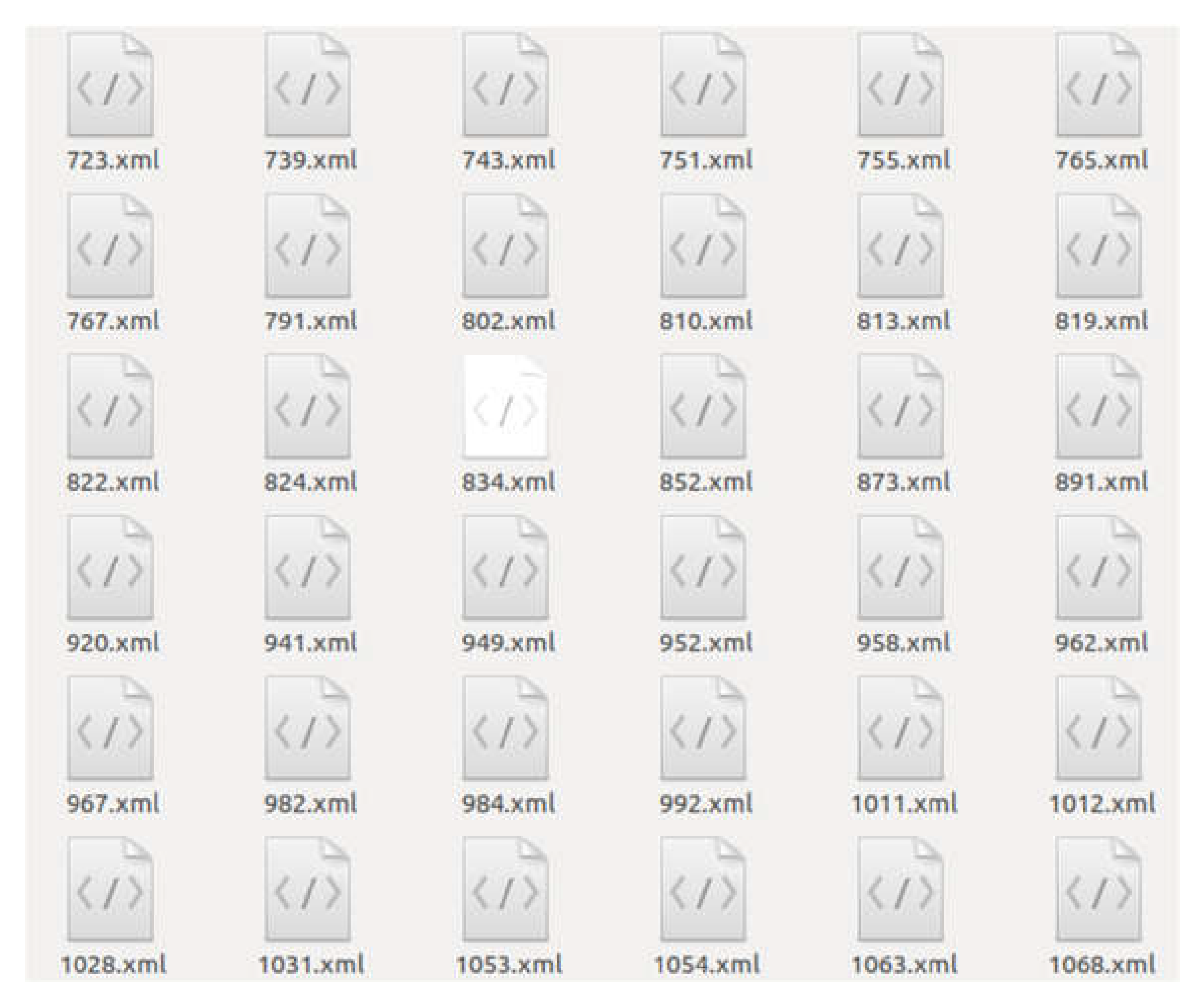
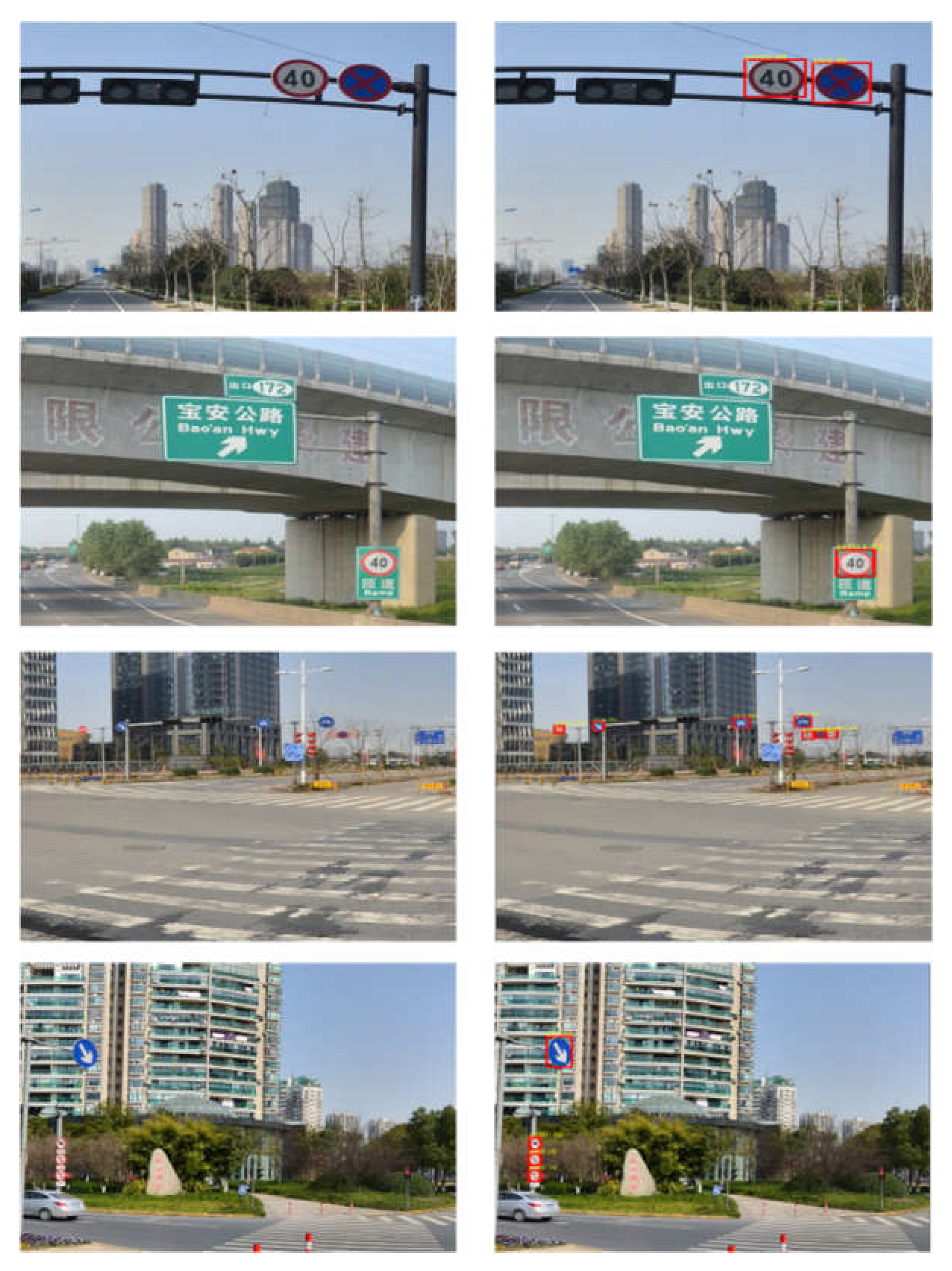
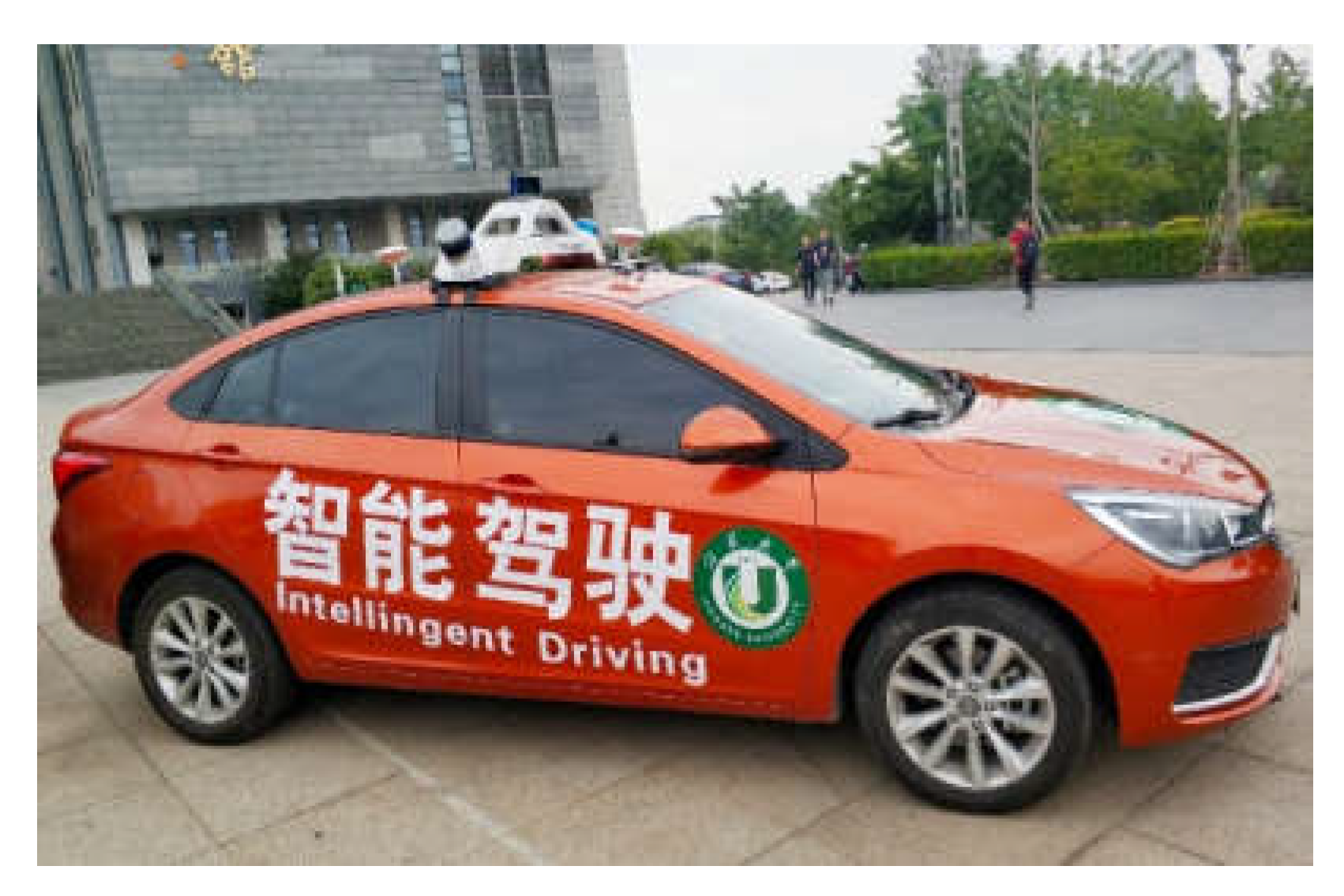


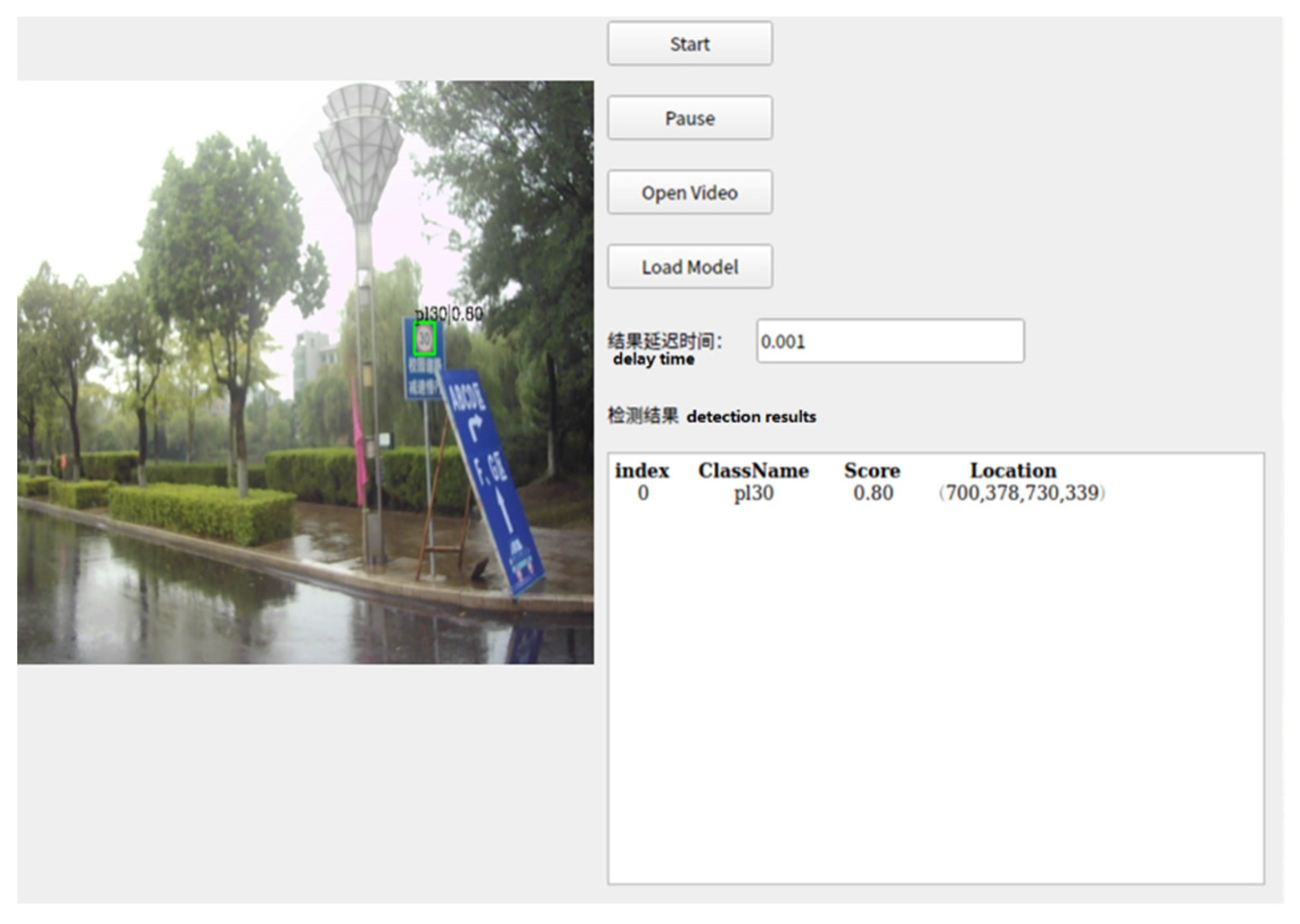
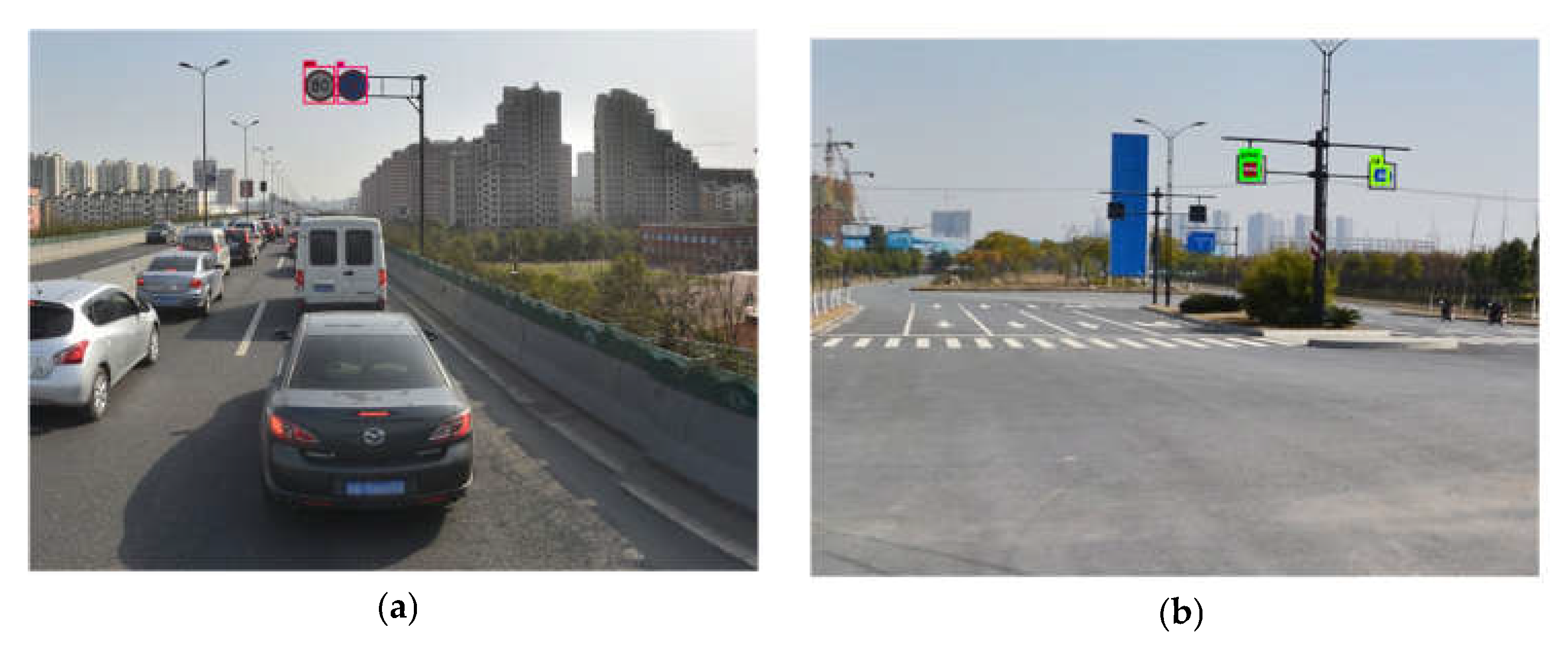
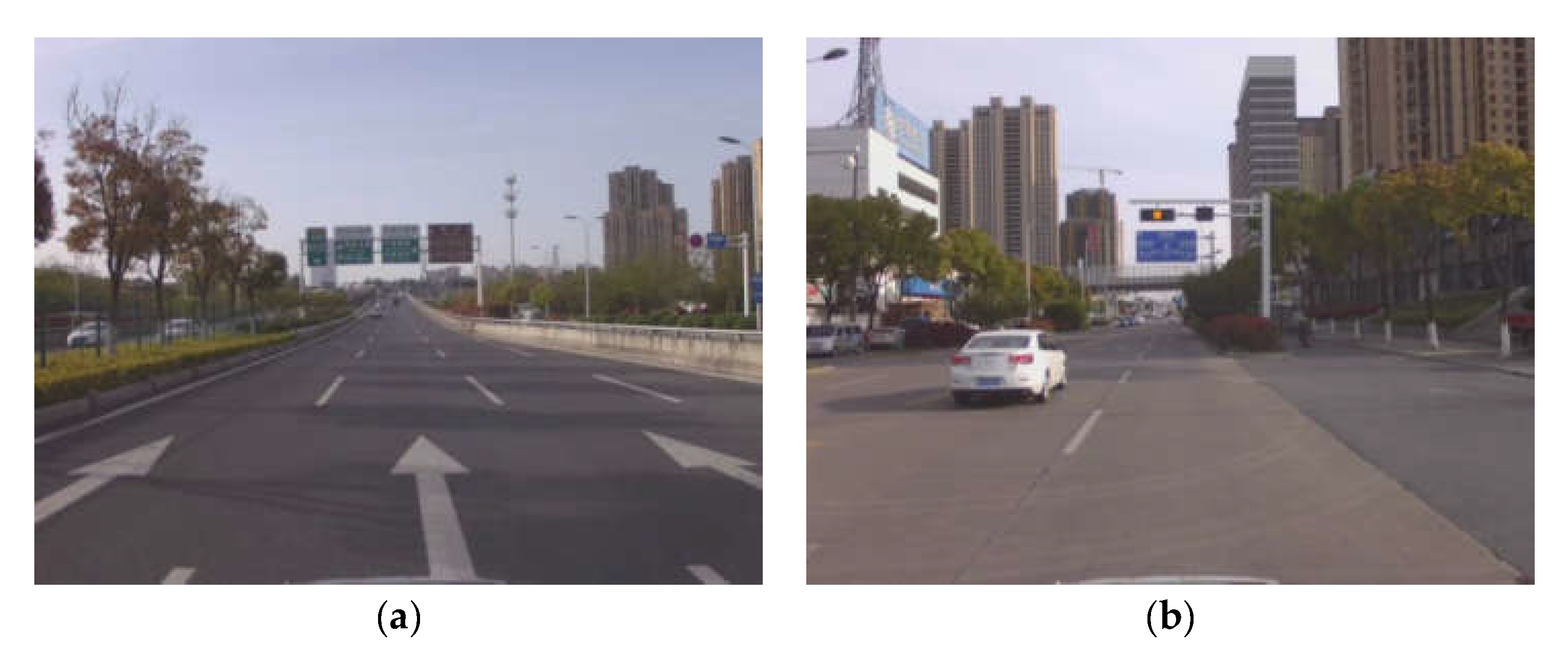
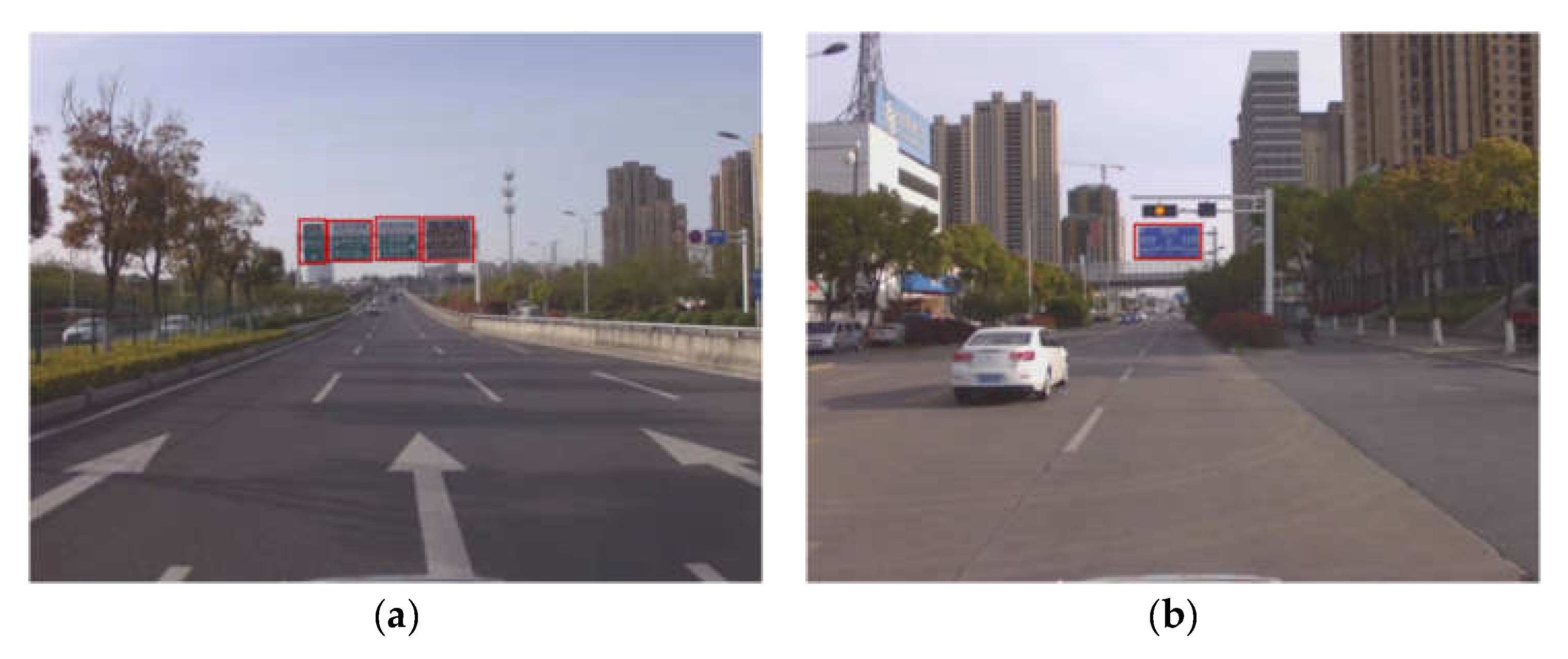
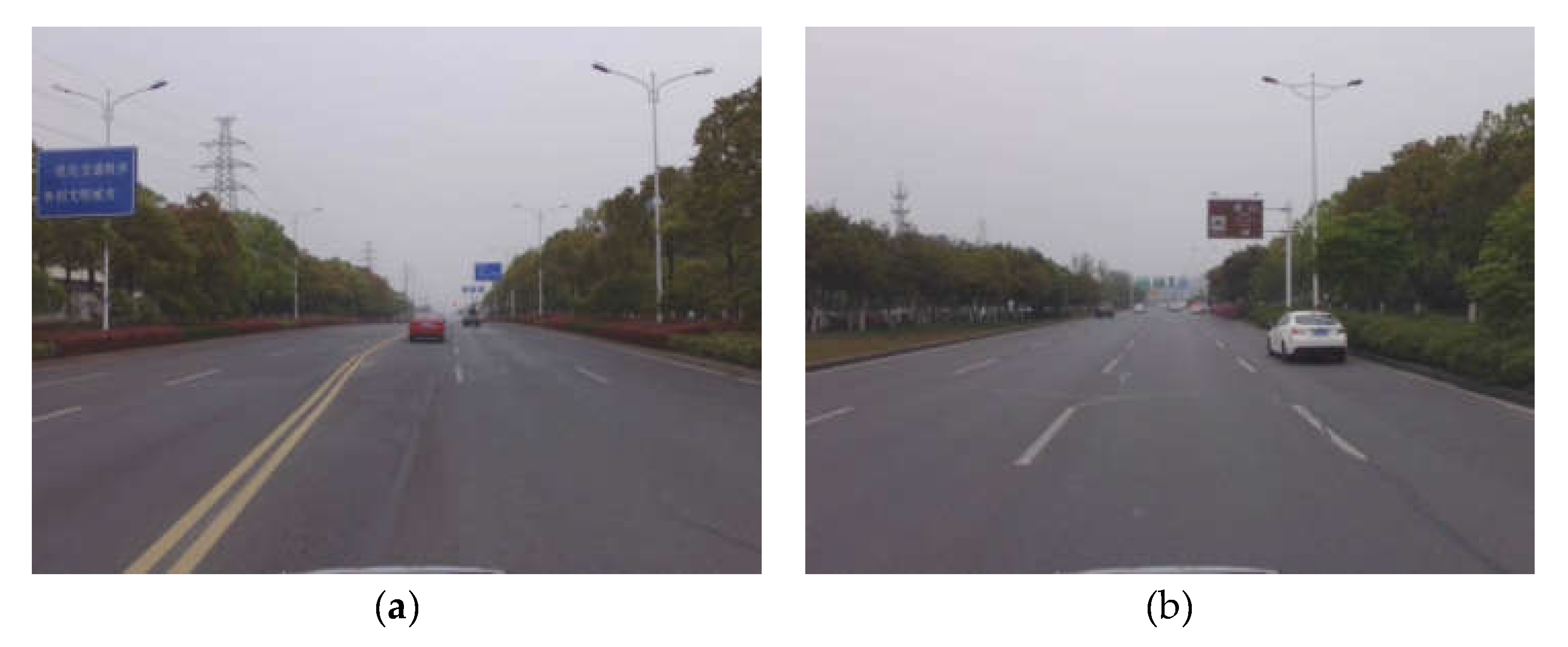
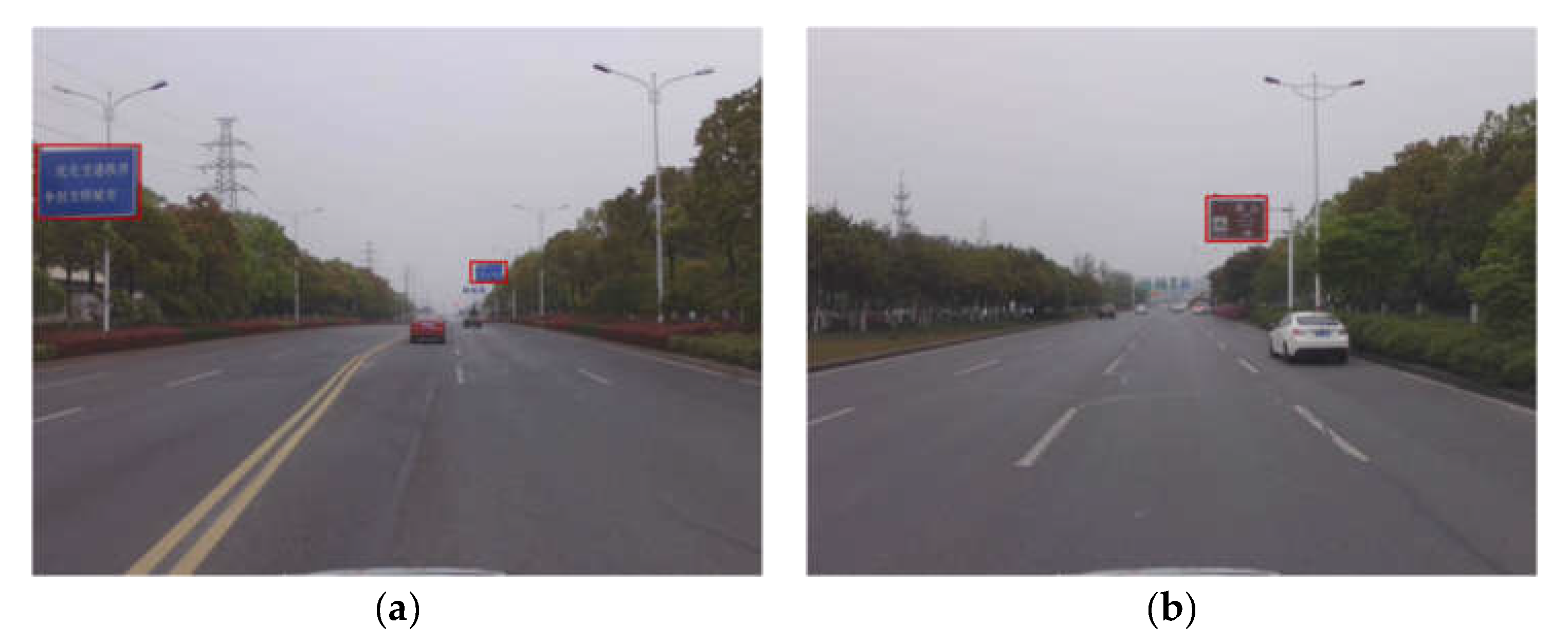
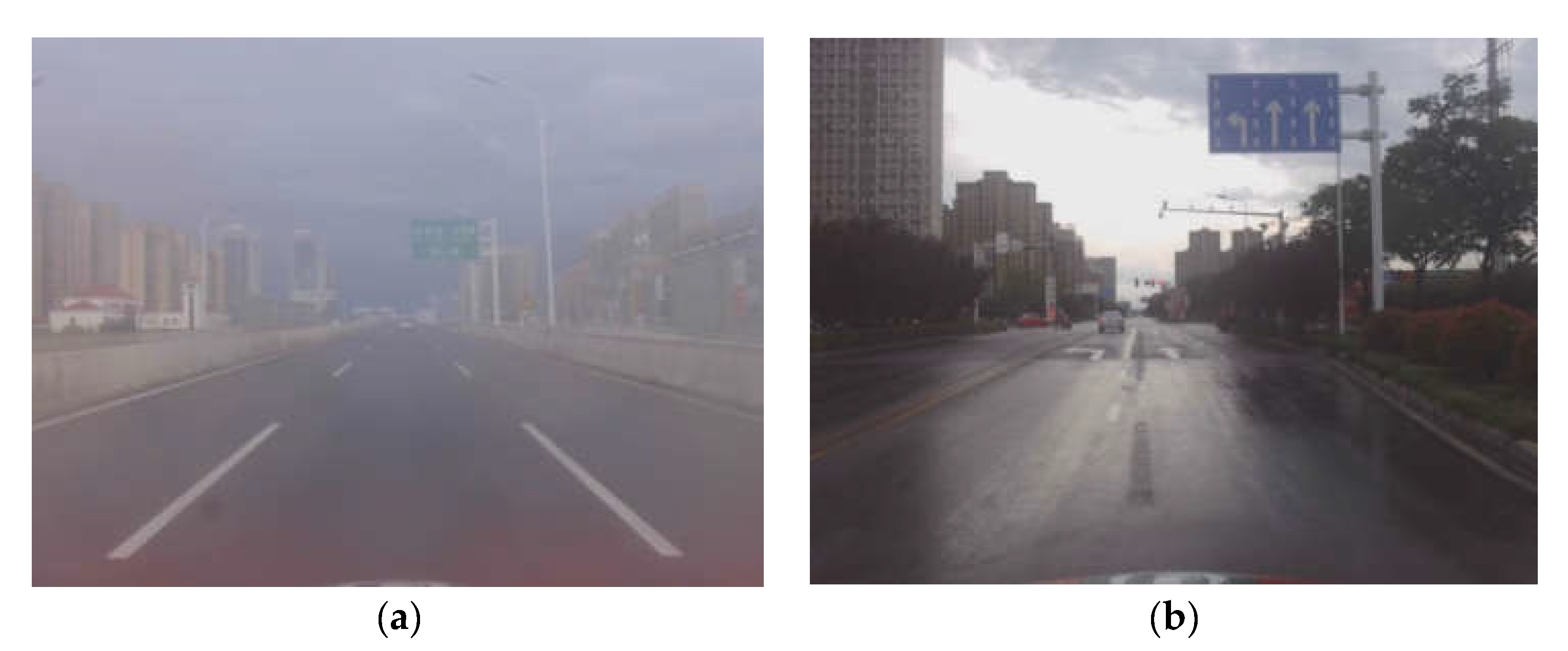
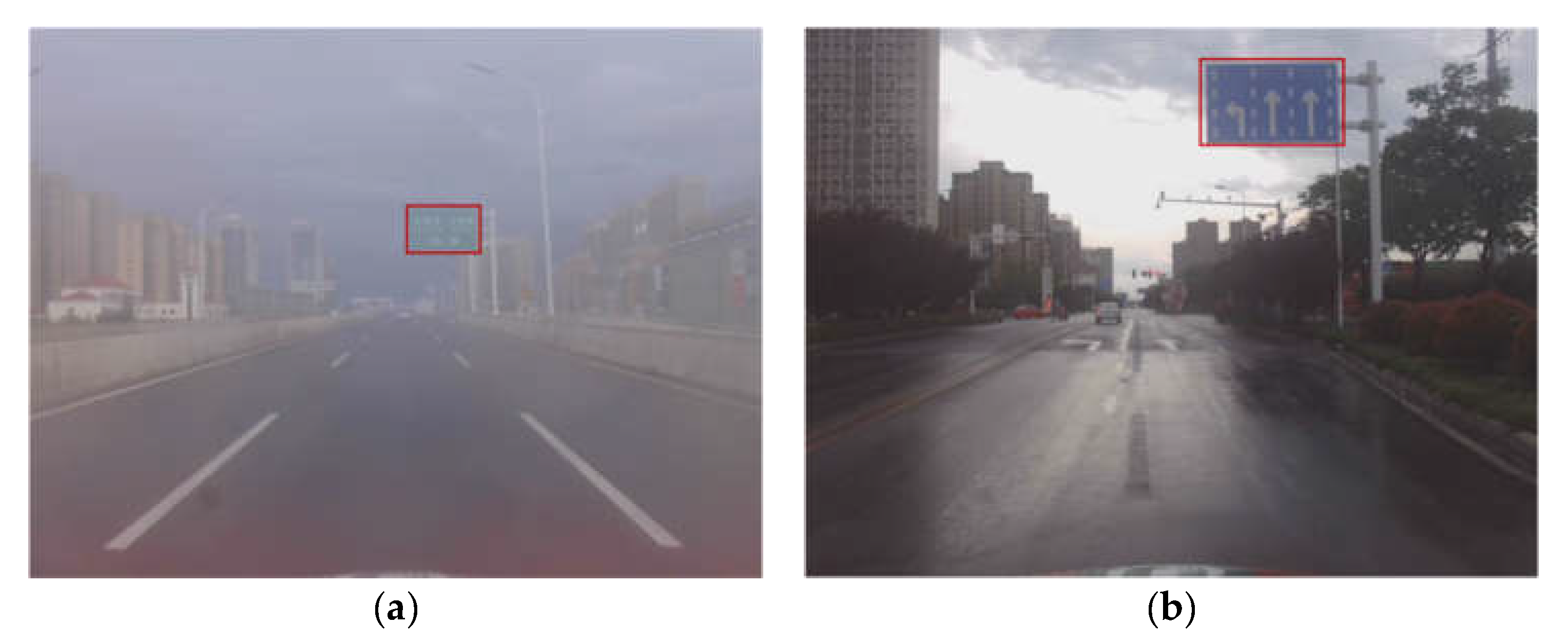
| Type | Target Number | Proportion (%) |
|---|---|---|
| Small target | 4226 | 44.93 |
| Medium target | 4412 | 46.90 |
| Large target | 768 | 8.17 |
| Model | mAP | FPS | |||
|---|---|---|---|---|---|
| Faster R-CNN | 0.748 | 0.812 | 0.805 | 0.782 | 9.3 |
| Faster R-CNN_ours | 0.861 | 0.874 | 0.836 | 0.865 | 8.4 |
| FPN | ROI Align | DCN | mAP | FPS | |||
|---|---|---|---|---|---|---|---|
| 0.748 | 0.812 | 0.805 | 0.782 | 9.3 | |||
| ✓ | 0.814 | 0.841 | 0.817 | 0.822 | 9.0 | ||
| ✓ | ✓ | 0.826 | 0.858 | 0.820 | 0.840 | 8.9 | |
| ✓ | ✓ | ✓ | 0.861 | 0.874 | 0.836 | 0.865 | 8.4 |
| Method | mAP | |||
|---|---|---|---|---|
| SSD | 0.752 | 0.650 | 0.744 | 0.728 |
| YOLOv2 | 0.784 | 0.712 | 0.752 | 0.744 |
| YOLOv3 | 0.808 | 0.796 | 0.832 | 0.806 |
| YOLOv5 | 0.924 | 0.956 | 0.968 | 0.948 |
| Faster-R-CNN_ours | 0.932 | 0.902 | 0.928 | 0.926 |
| Method | mAP | |||
|---|---|---|---|---|
| SSD | 0.682 | 0.638 | 0.658 | 0.664 |
| YOLOv2 | 0.626 | 0.690 | 0.752 | 0.694 |
| YOLOv3 | 0.696 | 0.784 | 0.712 | 0.724 |
| YOLOv5 | 0.832 | 0.906 | 0.874 | 0.876 |
| Faster-R-CNN_ours | 0.874 | 0.918 | 0.922 | 0.906 |
| Method | mAP | |||
|---|---|---|---|---|
| SSD | 0.494 | 0.558 | 0.647 | 0.519 |
| YOLOv2 | 0.451 | 0.572 | 0.685 | 0.546 |
| YOLOv3 | 0.529 | 0.633 | 0.708 | 0.624 |
| YOLOv5 | 0.717 | 0.839 | 0.751 | 0.766 |
| Faster-R-CNN_ours | 0.853 | 0.884 | 0.821 | 0.869 |
Publisher’s Note: MDPI stays neutral with regard to jurisdictional claims in published maps and institutional affiliations. |
© 2022 by the authors. Licensee MDPI, Basel, Switzerland. This article is an open access article distributed under the terms and conditions of the Creative Commons Attribution (CC BY) license (https://creativecommons.org/licenses/by/4.0/).
Share and Cite
Gao, X.; Chen, L.; Wang, K.; Xiong, X.; Wang, H.; Li, Y. Improved Traffic Sign Detection Algorithm Based on Faster R-CNN. Appl. Sci. 2022, 12, 8948. https://doi.org/10.3390/app12188948
Gao X, Chen L, Wang K, Xiong X, Wang H, Li Y. Improved Traffic Sign Detection Algorithm Based on Faster R-CNN. Applied Sciences. 2022; 12(18):8948. https://doi.org/10.3390/app12188948
Chicago/Turabian StyleGao, Xiang, Long Chen, Kuan Wang, Xiaoxia Xiong, Hai Wang, and Yicheng Li. 2022. "Improved Traffic Sign Detection Algorithm Based on Faster R-CNN" Applied Sciences 12, no. 18: 8948. https://doi.org/10.3390/app12188948
APA StyleGao, X., Chen, L., Wang, K., Xiong, X., Wang, H., & Li, Y. (2022). Improved Traffic Sign Detection Algorithm Based on Faster R-CNN. Applied Sciences, 12(18), 8948. https://doi.org/10.3390/app12188948






